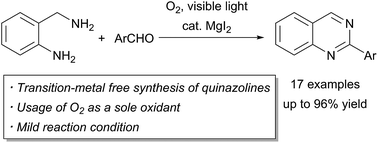Magnesium iodide-catalyzed synthesis of 2-substituted quinazolines using molecular oxygen and visible light†
Abstract
A novel and efficient approach for the synthesis of quinazolines by aerobic photooxidation with an iodine reagent at room temperature is reported. This method uses harmless visible light from compact fluorescent lamps and molecular oxygen as the sole oxidant without the need for a transition-metal catalyst or harsh reaction conditions.

- This article is part of the themed collection: Editors’ collection: Catalytic Organic Transformations

 Please wait while we load your content...
Please wait while we load your content...